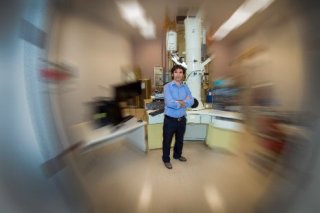Jul 21 2015
A team of researchers at Michigan Technological University has discovered an innovative approach to allow light waves to pass through a lens and protect them from being consumed.
 Durdu Guney stands in the lab where he and his team work on a metamaterial-based "perfect lens".
Durdu Guney stands in the lab where he and his team work on a metamaterial-based "perfect lens".
The study, published in the journal Physical Review Letters, is part of the work performed by Durdu Güney, a professor of electrical and computer engineering at Michigan Technological University. A drop of blood contains many microorganisms, including nanometer-sized viruses which cannot be seen through the naked eye.
This concept could soon become a reality with what researchers call a perfect lens. Although the lens is yet to be developed, it is a hypothetical metamaterial-based optical lens. Metamaterials are generally developed based on natural materials, but can be modified in the way they interact with light to have different optical properties.
While the metamaterial-based lens is nearly perfect, it is not completely foolproof. Over the past 15 years, intensive research has led to more and more challenges.
Güney teamed up with Mehdi Sadatgol, a PhD candidate at Technological University, and Lan Yang and Sahin Kaya Özdemir from the Department of Electrical and Systems Engineering of Washington University in St. Louis. “These findings open the possibility of reviving the early dreams of making ‘magical’ metamaterials from scratch”, the researchers wrote in their paper.
Metamaterials surpass the limits of plastic, glass, wood, metal and other natural materials. In order to realize this effect, the bases utilized for developing a metamaterial, similar to the thin silver films used by Güney’s team, are changed at the subwavelength scale, thus allowing light waves to interact with the material in novel ways. A perfect lens has not been developed, but the metal base tested by Güney’s group would resemble a standard glass lens; light would travel via the lens rather than reflecting off the metal.
“Aluminum and silver are the best choices so far in the visible light spectrum, not just for a perfect lens but all metamaterials,” Güney says, explaining that metamaterials have been successfully created with these metals, although they still tend to absorb light waves. “Loss—or the undesired absorption of light—is good in solar cells, but bad in a lens because it deteriorates the waves,” he explains.
One way to acquire a sharper image is to provide a sacrificial light wave. The solution to absorption lies in the light waves themselves, which tend to behave peculiarly in metamaterials. In order to produce their sci-fi light-bending characteristics, a perfect lens depends on negative index metamaterials.
Negative and positive refer to the way a material reacts to decaying and propagating light waves, which are similar to the yin and yang of optics. In majority of positive index materials, only propagating light waves are allowed to pass through, while negative index metamaterials not only allow propagating light waves to pass through but also increase the decaying light waves.
“In order for the perfect lens to work, you have to satisfy a lot of electromagnetic constraints,” Güney explains. “We don’t know how exactly the required optical modes [light waves in the material] need to be excited and protected in the lens for the perfect construction of an image.”
This existing challenge made the research team to try out other different ways to alter the metamaterial make-up introducing bulk, mode-by-mode nit-picking and intricate models. However, Güney and his group steered away from these difficulties and tried out the light itself.
In the plasmon-injection scheme, also known as π-scheme or pi-scheme, the team identified which light wave disintegrates as it travels via the negative index lens. They subsequently utilized this wave, which is ordained to fail in the lens, to protect the preferred light wave, thus enabling it to pass through the lens without getting consumed.
“With this approach, you can engineer this sacrificial wave,” Güney says. “It is difficult to construct this wave in other approaches.”
Advancements in this technology would require lightweight field equipment and more accessible medical technology.
“Imaging is one of the key technologies for this work,” Güney says, adding that a perfect lens could make science and medicine real for people. “It will make life easier to understand because people will be able to see it with their own eyes.”